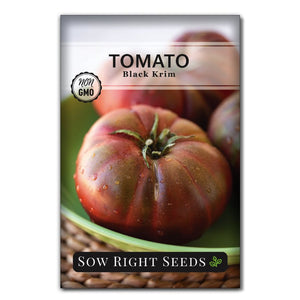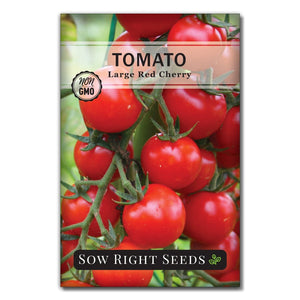Feed Your Tomatoes! A Complete Guide to Fertilizing Tomatoes
TomatoesUnderstanding the art of fertilizing tomatoes is essential to achieving a bountiful harvest. From the moment those tiny seedlings emerge from the soil to the day you pluck those juicy, ripe tomatoes off the vine, the right fertilization techniques can make all the difference. In this guide, we'll explore everything you need to know about nourishing your tomato plants from start to finish.

The Importance of Fertilizing Tomatoes
Gardeners talk about tomatoes as being “heavy feeders.” However, this doesn’t mean that you need to dump a lot of fertilizer on your tomato garden. It just means that tomato plants use a lot of nutrients. If you already have nutrient-rich soil, your tomatoes will grow just fine. But, if you want a maximum harvest or are starting from less than optimal soil, then extra fertilizer will be critical. And because tomatoes are heavy feeders, adding extra nutrients will result in healthier plants and a bigger harvest.
Should I fertilize my tomatoes?
Before adding fertilizer to your tomato plants, start with a soil test. You can get a soil test through your local University Extension Service or a commercial soil testing service.
The results you get will tell you what nutrients are in your garden soil and what deficiencies it may have. Everyone’s soil is a little different because of what they’ve already been growing and what has been added. So the results of your soil testing may be different from your neighbors.
Along with nutrients, a soil test can also tell you the pH of the soil. A pH range of 6.2 to 6.8 is optimal for tomatoes. Anything out of that range will affect tomato growth.
Once you know the nutrients in your soil, you can go forward with fertilizer applications.
The benefits of fertilizing tomatoes
When used appropriately, fertilizer can increase tomato yield and help produce better fruit. Using the right fertilizer at the right time will result in big healthy plants producing flowers and then developing delicious tomatoes.
When to fertilize tomatoes?
Timing is crucial when it comes to fertilizing tomato plants. Applying the right type of fertilizer at the right time ensures that the plants receive the nutrients they need at each growth stage.
So when is the right time to fertilize tomato plants? An easy way to know when to apply what nutrients is to break the tomato plant growth into 4 stages. It helps to think of your plants as seedlings, transplants, flowering, and fruiting.
Fertilizing tomatoes as seedlings -
You can start fertilizing tomatoes when they are seedlings. If you start your heirloom tomatoes from seed in a seed-starting mix, they will soon need additional nutrients. When tomato seedlings have at least two sets of true leaves, you can start applying a diluted fertilizer when watering. Be careful with applying fertilizer at this stage. These tender plants can easily be burned by too much fertilizer. Using a liquid fertilizer that is diluted to half strength will be sufficient. Water from the bottom to avoid getting fertilizer on the stem. A balanced fertilizer is best at this stage, as all parts of the plant are growing. Phosphorus will help with tissue development, and nitrogen will help with leaf growth.

Fertilizing tomatoes when transplanting -
When you transplant your tomato seedlings outdoors, ensure the garden soil is nutrient rich. If needed, before transplanting, work in some well-aged compost.
During this stage, tomato plants focus on leaf and stem growth. Nitrogen is particularly important during this phase, as it promotes lush foliage. Use a fertilizer with a higher nitrogen content, such as a 20-10-10 or 16-6-4 formulation. Apply the fertilizer around the base of the plants, keeping it about 6 inches away from the stem to prevent burning.
Fertilizing tomatoes when flowering -
Once your tomato plants are growing in their garden space, they will start producing flowers. When your tomato plants start putting out flowers, it is time to add phosphorus.
Switch to a fertilizer with a higher phosphorus content, such as a 10-20-10 or 5-10-10 formulation. Apply a dry fertilizer in a band around the plants, ensuring it is well-distributed and incorporated into the soil.

Fertilizing tomatoes when the fruit is starting to set -
During the fruit development stage, tomato plants require a balanced supply of nutrients to support healthy fruit growth and prevent nutrient deficiencies. Continue using a balanced fertilizer or switch to a slightly higher potassium content formulation, such as a 10-10-20 or 5-10-20 formulation.
At this stage, higher potassium content can result in more sugar in the fruit, which affects the flavor. Too much nitrogen will result in tomato puffiness, and the flavor won't be as good.
You can continue to apply the fertilizer as directed, taking care not to over-fertilize, as this can lead to excessive foliage growth and reduced fruit production. When the season is coming to an end, you can stop applying fertilizer.

How to apply fertilizer to tomato plants
Now that you know when to apply fertilizer. How do you do it without harming your plants and making sure that it’s available for the roots? We’ll take a look at how to apply liquid and dry fertilizers.
Liquid Fertilizers
Some types of fertilizers, such as fish emulsions, can be mixed with water, sprayed onto the leaves, and added during regular watering. A liquid or water-soluble fertilizer is a great option for container tomatoes.
Liquid fertilizers should be diluted and are usually applied more often. When using a liquid fertilizer, don’t water too close to the stem to avoid burning the stem and roots. Unless it is a fertilizer specifically formulated for spraying on leaves, you will want to avoid getting fertilizer on leaves and stems.
Dry Fertilizers
Dry fertilizers are sprinkled on the soil and then worked in gently and watered. Dry fertilizers usually release slowly over time and aren’t reapplied.
Before applying dry fertilizer, water your tomato plants. This will keep the roots from soaking up the fertilizer too greedily. When applying dry fertilizer, spread it around the plant without touching the stem. Fertilizer touching the stem and leaves can burn them.
Growing heirloom tomatoes from seed is so rewarding. It’s incredible how one tiny seed can give you bushels of delicious tomatoes for sauces and fresh eating. And the flavor of homegrown tomatoes is incomparable.
Common Mistakes in Fertilizing Tomatoes
While proper fertilization is crucial for tomato plants, gardeners often make several common mistakes. Avoiding these mistakes can help ensure the optimal health and productivity of your tomato plants.
The wrong nutrients at the wrong time.
Imbalanced Fertilization: Tomato plants require a balanced supply of nutrients. Applying too much of one nutrient and neglecting others can lead to nutrient imbalances and hinder overall plant health and productivity. Use fertilizers with balanced nutrient ratios or switch formulations as the plants progress through different growth stages.
Too much fertilizer
Over-Fertilizing: Over-fertilizing tomato plants can lead to excessive foliage growth at the expense of fruit production. It can also cause nutrient imbalances and burn the delicate roots. Always follow the recommended application rates and avoid the temptation of adding more fertilizer. With fertilizer, more is not better.
Applying fertilizer the wrong way
Poor Application Techniques: Proper application techniques are essential to ensure the nutrients are effectively delivered to the plant's root systems. Avoid applying fertilizer too close to the stem, as it can burn the plant and damage the delicate roots. Instead, distribute the fertilizer evenly around the plants, keeping it a few inches away from the stem.
What fertilizer to use
Knowing the fertilizer numbers and what they mean can help you know what fertilizer to use on your tomato plants.
Along with nitrogen, phosphorus, and potassium, tomatoes benefit from having calcium and magnesium available. Calcium will help prevent root rot.
When choosing a fertilizer for your tomato plants, pick one with the right NPK balance and then offer additional calcium and magnesium if your soil test shows a deficiency.
Compost is an excellent all-around fertilizer. It improves the health of the soil and will continue to give your plants all the nutrients they need. You can read more about adding compost to your garden.
The perfect tomato fertilizer for your garden is the one that works for soil conditions.
Signs Your Tomato Plants Need Fertilizer
Despite your best efforts, tomato plants may still experience nutrient deficiencies. Recognizing and addressing the symptoms promptly can help prevent further damage and ensure a successful harvest.
Nitrogen Deficiency: Symptoms of nitrogen deficiency include yellowing of older leaves, stunted growth, and overall poor plant vigor. To remedy this, apply a nitrogen-rich fertilizer, such as blood meal or fish emulsion, according to the package instructions.
Phosphorus Deficiency: A phosphorus deficiency can manifest as purplish discoloration on the leaves, reduced flower production, and delayed fruit ripening. To correct this deficiency, apply a phosphorus-rich fertilizer, such as bone meal or rock phosphate, as directed.
Potassium Deficiency: A potassium deficiency may cause yellowing and curling of leaf edges, weak stems, and reduced fruit quality. To address this deficiency, use a potassium-rich fertilizer, such as sulfate of potash or greensand, and apply according to the package instructions.
Signs of Too Much Nitrogen: Very dark green leaves that are almost bluish-green can be a sign of too much nitrogen. Another symptom of excess nitrogen is leaves that curl. To correct this, stop applying fertilizer, or use one that has a very low nitrogen content.
Best Practices for Tomato Fertilization
To make the most of your tomato fertilization efforts, keep the following best practices in mind:
1. Get Your Soil Tested: Conduct a soil test before planting to determine your soil's nutrient levels and pH. This will help you make informed decisions about fertilizer application and ensure the optimal nutrient balance for your tomato plants.
2. Follow the Instructions: Always follow the instructions provided on the fertilizer packaging. Applying too much or too little fertilizer can adversely affect your plant’s health. Under-fertilizing will result in less yield but over-fertilizing can burn your plant.
3. Water Properly: Proper watering is crucial for nutrient uptake. Water your tomato plants deeply and evenly to ensure the roots effectively absorb the nutrients.

The benefits of fertilizing tomatoes correctly are healthier plants and a bigger harvest.
Don’t fertilize your tomato plants just because everyone else is doing it. Find out what your soil needs, and then only apply fertilizer as needed.
Remember to water your tomato plants consistently and evenly. Apply fertilizer as needed and enjoy a delicious harvest of heirloom tomatoes. You’ll know you’ve grown them right when you slice into that juicy, delicious tomato.
We love sharing our gardening wisdom to get you past the confusion that often comes with applying fertilizer. Follow our simple fertilizing method to grow a bumper crop of fresh heirloom tomatoes.








Very educative and directive
Please which type of seed is good for dry season tomato production
Leave a comment